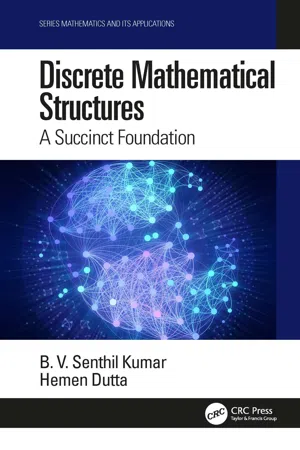
- 262 pages
- English
- ePUB (mobile friendly)
- Available on iOS & Android
About this book
This book contains fundamental concepts on discrete mathematical structures in an easy to understand style so that the reader can grasp the contents and explanation easily. The concepts of discrete mathematical structures have application to computer science, engineering and information technology including in coding techniques, switching circuits, pointers and linked allocation, error corrections, as well as in data networking, Chemistry, Biology and many other scientific areas. The book is for undergraduate and graduate levels learners and educators associated with various courses and progammes in Mathematics, Computer Science, Engineering and Information Technology. The book should serve as a text and reference guide to many undergraduate and graduate programmes offered by many institutions including colleges and universities. Readers will find solved examples and end of chapter exercises to enhance reader comprehension.
Features
-
- Offers comprehensive coverage of basic ideas of Logic, Mathematical Induction, Graph Theory, Algebraic Structures and Lattices and Boolean Algebra
- Provides end of chapter solved examples and practice problems
- Delivers materials on valid arguments and rules of inference with illustrations
- Focuses on algebraic structures to enable the reader to work with discrete structures
Frequently asked questions
- Essential is ideal for learners and professionals who enjoy exploring a wide range of subjects. Access the Essential Library with 800,000+ trusted titles and best-sellers across business, personal growth, and the humanities. Includes unlimited reading time and Standard Read Aloud voice.
- Complete: Perfect for advanced learners and researchers needing full, unrestricted access. Unlock 1.4M+ books across hundreds of subjects, including academic and specialized titles. The Complete Plan also includes advanced features like Premium Read Aloud and Research Assistant.
Please note we cannot support devices running on iOS 13 and Android 7 or earlier. Learn more about using the app.
Information
1
Logics and Proofs
1.1 Introduction
1.2 Proposition
- (i) The year 2000 is a leap year.
- (ii) 5 + 3 = 7.
- (iii) x = 1 is a solution of x3 = 1.
- (iv) Close the door.
1.3 Compound Propositions
Table of contents
- Cover
- Half Title
- Series Page
- Title Page
- Copyright Page
- Table of Contents
- Preface
- Authors
- 1 Logics and Proofs
- 2 Combinatorics
- 3 Graphs
- 4 Algebraic Structures
- 5 Lattices and Boolean Algebra
- Bibliography
- Index